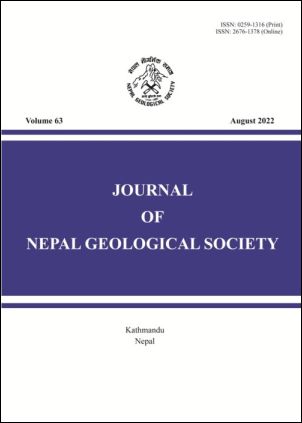Hydro-geochemical characterization and suitability analysis of spring water of the Mai Khola Watershed, Ilam, eastern Nepal
DOI:
https://doi.org/10.3126/jngs.v63i01.50847Keywords:
Hydrogeochemistry, groundwater characterization, springs, WQI, suitabilityAbstract
The interaction of different physical and chemical factors as well as anthropogenic activities influences the chemistry of groundwater. The hydro-geochemical assessment of the groundwater is the basic part of the water resources management and its assessment in regards to its usability is considered vital. The study involves the measurement of physicochemical parameters (pH, EC, EH, DO, TDS) of the observed 147 springs and the ionic concentration of the representative 32 springs along the Mai Khola Watershed using standard analytical procedure. The results of the physicochemical parameters and ionic concentration were analysed and interpreted using different indices and graphical methods. The physicochemical parameter suggests that spring water is weakly acidic to alkaline and the measured EC and TDS suggest low interaction of rocks and water therein. The piper diagram indicates Ca2+ and Mg2+ together (alkaline earth metals) dominate over combined Na+ and K+ (alkali metals) and Cl- and SO42- (strong acids) predominate over HCO3- (weak ones). The Gibbs plot also satisfies the movement of groundwater from the precipitation domain to the rock-water interaction domain. The groundwater in this area is derived from a shallow aquifer with low rock-water interaction and the water is good for drinking purpose and excellent to good for irrigation. The spring water in the study area possesses no threat to quality deterioration, however proper management and conservation plans are required to maintain the quality of the water.
Downloads
Downloads
Published
How to Cite
Issue
Section
License
© Nepal Geological Society




